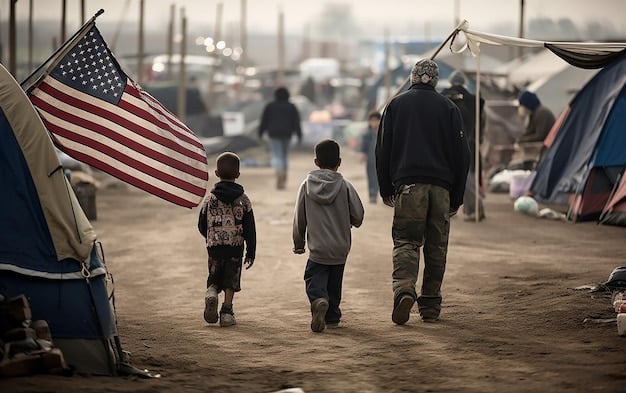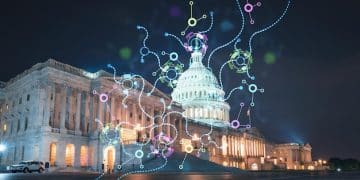US Response to Refugee Crisis: Policies & Future Challenges

Advertisements
The United States addresses the global refugee crisis through a complex interplay of domestic and international policies encompassing asylum processing, resettlement, and humanitarian aid, yet faces significant future challenges in capacity, funding, and international cooperation.
Advertisements
The global refugee crisis is an issue of immense complexity and profound human impact, demanding robust and compassionate responses from nations worldwide. When examining How is the US Addressing the Global Refugee Crisis? A Breakdown of Current Policies and Future Challenges, it becomes clear that the nation’s approach is multifaceted, evolving, and subject to continuous domestic and international pressures.
Understanding the Current Landscape of US Refugee Policy
The United States has historically been a significant player in international humanitarian efforts, providing refuge and assistance to those fleeing persecution and conflict. This section delves into the foundational elements of current US refugee policy, outlining the legal frameworks and operational mechanisms that guide its approach to the global refugee crisis.
Advertisements
Legal Frameworks and International Obligations
The US refugee system is built upon a combination of domestic laws and international agreements. The Refugee Act of 1980 is a cornerstone, codifying the definition of a refugee in line with the 1951 Refugee Convention and its 1967 Protocol, to which the US is a signatory. This legislation established the federal refugee resettlement program, setting annual limits on admissions and outlining paths to asylum. The government’s approach is designed to provide immediate protection and facilitate long-term integration.
- The 1951 Refugee Convention and 1967 Protocol define “refugee” and outline states’ obligations.
- The Refugee Act of 1980 established the federal resettlement program and asylum process.
- Various executive orders and departmental regulations further refine policy implementation.
Key Agencies and Their Roles
Several government agencies collaborate to manage the US response to the refugee crisis. The Department of State, particularly its Bureau of Population, Refugees, and Migration (PRM), leads humanitarian diplomacy and allocates funding for international relief efforts. The Department of Homeland Security (DHS), through US Citizenship and Immigration Services (USCIS), handles asylum claims and refugee admissions. Within the Department of Health and Human Services (HHS), the Office of Refugee Resettlement (ORR) provides services to help refugees integrate into American society. The intricate coordination among these entities is crucial for a coherent and effective response. The collaborative effort spans from processing applications abroad to providing initial support and long-term integration programs within the United States.
The US commitment extends beyond its borders, with significant contributions to international organizations. The nation is a major donor to the United Nations High Commissioner for Refugees (UNHCR) and other humanitarian agencies, supporting their work in refugee camps, providing emergency aid, and advocating for durable solutions. This global engagement underscores an understanding that the refugee crisis requires a multilateral approach, addressing root causes and supporting host countries bearing the brunt of large-scale displacement. Overall, the current US policy landscape is a complex tapestry of legal obligations, inter-agency coordination, and international partnerships, all aimed at providing protection and assistance while balancing national interests and capacities.
Asylum and Resettlement Pathways: Processes and Challenges
The United States offers two primary pathways for individuals seeking protection: asylum and refugee resettlement. While both aim to provide safety, they differ significantly in their processes, eligibility criteria, and the challenges they present. This section explores these pathways in detail, highlighting the intricacies and obstacles faced by both applicants and the US government.
The Asylum Process
Asylum is available to individuals already present in the United States or at a US port of entry, regardless of their nationality, who fear persecution in their home country. The process typically begins with an affirmative asylum application filed with USCIS. If the application is not granted, or if the individual arrived without authorization, their case may be referred to an immigration judge for defensive asylum proceedings. This dual track ensures multiple layers of review, although it also creates backlogs and can prolong the uncertainty for applicants.
- Applicants must demonstrate a well-founded fear of persecution based on race, religion, nationality, political opinion, or membership in a particular social group.
- The process involves interviews, background checks, and judicial review for defensive claims.
- Significant backlogs exist, leading to prolonged waiting times for decisions.
The Refugee Resettlement Program
Refugee resettlement, in contrast to asylum, is for individuals who seek protection from outside the United States, typically from refugee camps or transit countries. This program is managed by UNHCR and US government agencies, working in tandem to identify, vet, and admit vulnerable individuals. Candidates for resettlement undergo rigorous security checks, medical screenings, and cultural orientation before being approved to travel to the US. Once admitted, they receive initial assistance from resettlement agencies to help them integrate into American communities.
This pathway also faces substantial challenges. Fluctuations in annual Presidential Determinations on Refugee Admissions (PDRA) significantly impact the number of refugees allowed into the country. The lengthy and intensive vetting process, while crucial for national security, can take years, leaving vulnerable individuals in limbo. Furthermore, the capacity of resettlement agencies, which rely on federal funding and community support, can be strained by sudden changes in admission numbers or unforeseen global events. The balance between maintaining robust security protocols and ensuring timely protection for refugees remains a delicate and ongoing challenge within the resettlement program. Political will, public support, and geopolitical realities continuously shape the program’s scope and effectiveness, influencing how many individuals the US can meaningfully assist each year.
Humanitarian Aid and International Cooperation
Beyond its borders, the United States plays a crucial role in addressing the global refugee crisis through extensive humanitarian aid and robust international cooperation. This proactive engagement is essential for managing the immediate needs of displaced populations and fostering long-term stability in regions affected by conflict and disaster.
Financial Contributions and Aid Programs
The US is consistently one of the largest donors of humanitarian assistance worldwide. This aid is channeled through various avenues, including direct funding to international organizations, support for non-governmental organizations (NGOs), and bilateral assistance to host countries. Funds are allocated for life-saving aid such as food, shelter, water, sanitation, and medical supplies in displacement settings. These contributions are critical in alleviating suffering in protracted crises and responding swiftly to new emergencies.
The scale of US humanitarian funding reflects a recognition that addressing displacement at its source is often more effective and humane than managing its overflow. Programs supported by US aid range from emergency response in active conflict zones to long-term development initiatives aimed at building resilience in host communities. This encompasses efforts to improve education, livelihood opportunities, and healthcare access for both refugees and their host communities, thereby reducing reliance on aid and promoting self-sufficiency.
Multilateral Engagements and Diplomacy
International cooperation is a cornerstone of the US approach to the global refugee crisis. The United States actively engages with multilateral bodies such as the United Nations High Commissioner for Refugees (UNHCR), the International Organization for Migration (IOM), and the World Food Programme (WFP). This engagement involves not only financial support but also diplomatic efforts to promote burden-sharing, advocate for refugee rights, and find durable solutions.
Through diplomatic channels, the US works to encourage other nations to uphold international refugee law, process asylum claims fairly, and contribute to humanitarian efforts. It also participates in global forums to address root causes of displacement, such as political instability, climate change, and economic disparities. This collaborative approach recognizes that no single nation can solve the global refugee crisis alone. By leveraging its diplomatic influence and financial resources, the US seeks to build a more coordinated and effective international response, ensuring that the burden of displacement is shared more equitably and that vulnerable populations receive the protection and assistance they need. The effectiveness of this cooperation is often tested by geopolitical shifts and the escalating scale of global displacement, demanding continuous adaptation and commitment.

Challenges and Critiques of Current US Policies
Despite its significant contributions, the United States’ approach to the global refugee crisis is not without its challenges and faces considerable critique. These issues often revolve around the balance between security, humanitarian obligations, and domestic political considerations, impacting the effectiveness and perceived compassion of US policies.
Evolving Domestic Political Landscape
The political climate within the United States significantly influences refugee and asylum policies. Changes in administration often bring shifts in priorities, leading to swings in refugee admission numbers and alterations in asylum processing procedures. During some periods, there have been significant reductions in refugee intake, leading to concerns about the US’s commitment to its international obligations and its historical role as a haven.
These shifts are often driven by national security concerns, economic anxieties, and differing ideological perspectives on immigration. The politicization of refugee issues can create an unpredictable environment for both those seeking protection and the organizations that assist them. This variability complicates long-term planning for resettlement agencies and can leave vulnerable populations in prolonged uncertainty, impacting their ability to rebuild their lives.
Capacity Strain and Resource Allocation
The sheer scale of global displacement, coupled with sometimes fluctuating federal funding, places considerable strain on the US refugee and asylum system. Backlogs in asylum applications have swelled, leading to delays that can span years, increasing hardship for applicants waiting for decisions. Similarly, the capacity of resettlement agencies, which are vital for integrating refugees, can be stretched thin, impacting their ability to provide comprehensive services.
Challenges also arise in allocating resources effectively across both domestic processing and international humanitarian aid. Balancing the needs of those seeking asylum at the border with those awaiting resettlement abroad, while also contributing to aid efforts in host countries, requires strategic and flexible resource management. The lack of consistent, predictable funding can hinder the ability to adapt to new crises and maintain robust programs, forcing difficult choices about where and how to best direct assistance. Addressing these capacity issues requires sustained political will and a clear vision for a comprehensive, long-term strategy.
Future Challenges and the Path Forward
As the global refugee crisis continues to evolve, presenting new complexities and increasing scales of displacement, the United States faces significant future challenges in its response. Adapting to these dynamics and forging a more sustainable path forward will require strategic foresight, innovative approaches, and renewed commitment.
Climate Change and New Drivers of Displacement
One of the most pressing future challenges is the escalating impact of climate change. Environmental degradation, sea-level rise, extreme weather events, and resource scarcity are increasingly acting as direct and indirect drivers of displacement, creating new categories of vulnerable populations often referred to as “climate refugees.” Current international and domestic legal frameworks are not always equipped to address the specific needs and legal status of individuals displaced solely by environmental factors.
The US will need to consider how its immigration laws and humanitarian programs can adapt to this emerging reality. This includes potentially developing specific protections or pathways for climate-displaced persons, investing in climate resilience abroad to prevent forced migration, and engaging in international dialogues to establish global norms for addressing climate-induced displacement. Ignoring this rapidly growing challenge would be to overlook a fundamental shift in the nature of global mobility.
Strengthening Integration and Community Support
Beyond initial resettlement, a critical future challenge lies in ensuring successful long-term integration for refugees within American communities. This requires sustained support for language acquisition, educational opportunities, workforce development, and mental health services. While initial resettlement assistance is crucial, the absence of robust, continuous integration services can lead to isolation, economic hardship, and slower pathways to self-sufficiency.
Strengthening community support networks, fostering public understanding and empathy, and leveraging both governmental and non-governmental resources will be essential. This also entails addressing issues of housing affordability, access to healthcare, and combating xenophobia. A truly effective refugee policy extends beyond arrival, encompassing efforts to enable newcomers to thrive and contribute fully to American society.
Innovation in Processing and International Cooperation
To address mounting backlogs and increase efficiency, the US system will need to embrace innovation in its processing of asylum claims and refugee applications. This could involve greater use of technology, streamlining administrative procedures, and increasing staffing for relevant agencies. The goal should be to expedite fair and thorough adjudication processes, reducing the lengthy waiting periods that impose significant burdens on applicants.
Furthermore, adapting to future challenges demands even stronger international cooperation. This includes working with allies to ensure equitable burden-sharing, developing regional protection frameworks, and collectively addressing the root causes of displacement, from conflict prevention to sustainable development. The efficacy of the US response will increasingly depend on its ability to act collaboratively on a global stage, recognizing that the refugee crisis is a shared human challenge that transcends borders. The path forward is one of continuous adaptation, informed by humanitarian principles and strategic foresight.
The Role of Non-Governmental Organizations (NGOs)
Non-governmental organizations (NGOs) are indispensable partners in the United States’ response to the global refugee crisis. Their roles range from direct service provision to advocacy, often filling critical gaps in government programs and acting as a bridge between official policies and the lived realities of displaced individuals.
Resettlement and Integration Services
At the forefront of direct assistance are the nine national resettlement agencies, such as HIAS, Lutheran Immigration and Refugee Service (LIRS), and the US Conference of Catholic Bishops (USCCB), which receive federal funding to help refugees rebuild their lives in the US. These agencies and their local affiliates are responsible for a wide array of services that extend beyond initial arrival. Their work includes securing housing, enrolling children in school, connecting adults with employment opportunities, and providing cultural orientation.
Without these organizations, the federal government would struggle to operationalize its resettlement goals. They provide crucial on-the-ground support, navigating complex bureaucratic systems and ensuring that new arrivals receive the foundational elements necessary for successful integration. This comprehensive support helps to mitigate the initial shock of displacement and creates pathways for community engagement and economic self-sufficiency.
Advocacy and Policy Influence
Beyond direct services, many NGOs play a vital role in advocating for refugees’ rights and influencing US policy. Organizations such as the International Rescue Committee (IRC), Amnesty International, and Human Rights Watch actively monitor humanitarian crises, document human rights abuses, and lobby lawmakers for policies that are more compassionate and effective. They publish reports, campaign for increased refugee admissions, and highlight areas where US policy falls short of international norms or humanitarian ideals.
Their advocacy often translates into public awareness campaigns, generating support for refugees and combating xenophobic narratives. By providing expert analysis and firsthand accounts, NGOs contribute to a more informed public discourse and pressure policymakers to respond to the crisis in a manner consistent with American values and international obligations. Their dual role as service providers and advocates makes them invaluable components of the US response, ensuring that both immediate needs and long-term systemic issues are addressed. The sustained engagement of NGOs is therefore crucial for maintaining the humanitarian integrity and practical effectiveness of the US approach to the global refugee crisis.
Economic and Social Impacts in the US
The integration of refugees into American society carries substantial economic and social impacts, often sparking nuanced debates about costs, benefits, and cultural adaptation. While the initial costs of resettlement are evident, long-term studies frequently point to net positive contributions from refugee communities.
Economic Contributions
Far from being solely a recipient of aid, refugees often become vibrant economic contributors to their new communities. Initially, there are costs associated with humanitarian assistance and resettlement services. However, over time, refugees establish businesses at higher rates than the native-born population, fill labor shortages, and pay taxes. They often take on jobs that native-born workers may be less willing to do, particularly in certain sectors like agriculture, meatpacking, and hospitality.
Studies have shown that refugees, over a period of years, contribute more in taxes than they receive in benefits. They revitalize declining neighborhoods, contribute to local economies through consumer spending, and introduce new skills and perspectives that foster innovation. The long-term economic benefits often outweigh the short-term costs, representing a significant return on investment for the host country.
Social and Cultural Integration
The social impact of refugee integration is equally profound, enriching the cultural fabric of American society. Refugees bring diverse languages, culinary traditions, artistic expressions, and religious practices, contributing to a more vibrant and multicultural nation. Schools, community centers, and religious institutions often become key sites for interaction and integration, fostering a richer social tapestry.
However, social integration is not without challenges. Language barriers, cultural differences, and discrimination can impede the process. Efforts to promote successful integration involve community outreach, interfaith dialogues, and public education campaigns aimed at fostering understanding and dispelling misconceptions. While challenges exist, the long-term social benefits include increased diversity, stronger community ties, and a more robust and resilient society. The adaptability and resilience of refugees, coupled with community support networks, contribute to a dynamic social landscape that enriches the broader American experience. The ongoing reciprocal exchange between newcomers and established communities fundamentally shapes the nation’s evolving identity.

| Key Aspect | Brief Description |
|---|---|
| ⚖️ Legal Framework | The US operates under the Refugee Act of 1980, aligning with international conventions for asylum and resettlement. |
| 🔄 Pathways | Both in-country asylum and overseas refugee resettlement are available, each with distinct processes and challenges. |
| 🌐 Global Aid | The US is a leading humanitarian aid donor, supporting international organizations and host countries. |
| 🔮 Future Issues | Climate change displacement, capacity strain, and social integration are key future challenges. |
Frequently Asked Questions (FAQ)
▼
The primary legal basis is the Refugee Act of 1980, which aligns US law with international refugee conventions, including the 1951 Refugee Convention and its 1967 Protocol. This act defines “refugee” and established the framework for both the federal refugee resettlement program and the asylum process in the United States for individuals fleeing persecution.
▼
Asylum applies to individuals already in the US or at a port of entry seeking protection from persecution. Refugee resettlement is for individuals outside the US, typically referred by UNHCR from refugee camps, who undergo extensive vetting abroad before being admitted to the country under an established annual quota set by the President.
▼
Non-governmental organizations (NGOs) are crucial. They provide direct resettlement services like housing, employment assistance, and cultural orientation. Additionally, many NGOs act as advocates, influencing policy, raising public awareness, and ensuring the rights and well-being of refugees are championed within the US and internationally.
▼
Significant future challenges include addressing climate-induced displacement, which current frameworks may not fully cover. Other challenges involve managing persistent backlogs in asylum processing, ensuring successful long-term integration for new arrivals, and adapting to global geopolitical shifts that constantly alter the scale and nature of forced migration worldwide.
▼
Yes, refugees contribute significantly to the US economy. While there are initial resettlement costs, studies often show that refugees establish businesses at higher rates, fill labor gaps, and pay taxes, often contributing more in taxes over time than they receive in benefits. They also bring diverse skills and contribute to local economies through consumer spending and entrepreneurship.
Conclusion
How is the US Addressing the Global Refugee Crisis? A Breakdown of Current Policies and Future Challenges reveals a complex and often contradictory landscape. While the United States maintains a foundational legal framework and demonstrates a historical commitment to humanitarian aid and resettlement, its policies are subject to significant political fluctuations, capacity constraints, and evolving global dynamics, particularly the burgeoning challenge of climate-induced displacement. Moving forward, the effectiveness of the US response will hinge not only on consistent political will and robust funding but also on innovative approaches to processing, strengthened integration efforts, and unwavering international cooperation. The nation’s ability to adapt and uphold its humanitarian principles will define its role in addressing one of humanity’s most pressing challenges.





